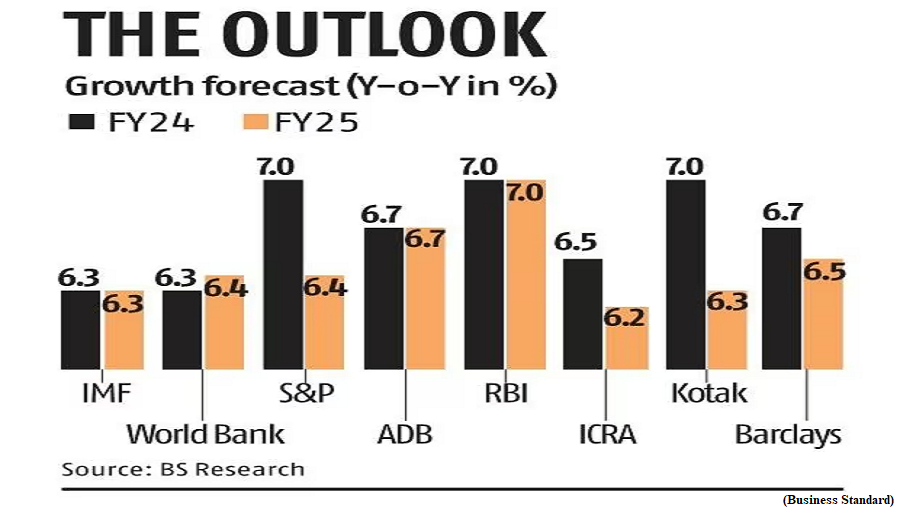FinMin says economy likely to grow closer to 7 percent in 2024-25

Why in news?
- Recently, report titled ‘The Indian Economy: A Review’ was released by the Department of Economic Affairs, which also offered a “brief sketch of the outlook for the economy in the coming years.
Details:
- It pegged India’s real GDP growth at closer to 7% in 2024-25 with ‘considerable scope’ to outpace 7% by 2030.
- It predicted that the economy will hit $5 trillion in the next three years, making it the third largest in the world.
- The prognosis of 7% growth in the coming year, if actualised, would mean 7% or higher growth for four years in a row.
Key Highlights:
- The review split India’s growth story into two phases; 1950 to 2014 and ‘2014-2024: Decade of transformative growth’ and noted that despite some positive developments.
- The economy had clocked lower than 5% growth of GDP at factor cost at constant prices for two consecutive years, 2012-13 and 2013-14, food inflation was high, and structural constraints such as difficulties in quick decisions on projects, ill-targeted subsidies cramping fiscal space for public investment, and a large informal sector, were denting growth.
Structural reforms:
- Since then, the Indian economy has undergone many structural reforms that have strengthened its macroeconomic fundamentals.
- These reforms have led to India emerging as the fastest-growing economy among G20 economies, noting that the economy is generating jobs and an impressive post-pandemic recovery has seen urban unemployment rate decline to 6.6%.
- While the report outlined key reforms such as the introduction of the Goods and Services Tax and the Insolvency and Bankruptcy Code, along with the push to build infrastructure, it only refers to Demonetisation in passing, noting that it led to a surge in the use of non-cash forms of payment.
Status Report of Snow Leopards in India
(GS Paper 3, Environment)
Why in news?
- Recently, the Union Minister of Environment, Forest, and Climate Change released the report on the Status of Snow leopards in India.
- The Snow Leopard Population Assessment in India (SPAI) Program is the first-ever scientific exercise that reports Snow leopard population of 718 individuals in India.
- The Wildlife Institute of India (WII) is the National Coordinator for this exercise that was carried out with support the support of all snow leopard range states and two conservation partners.

SPAI exercise:
- The SPAI systematically covered over 70% of the potential snow leopard range in the country, involving forest & wildlife staff, researchers, volunteers, and contributions from knowledge partners.
- Covering approximately 120,000km2 of crucial Snow leopard habitat across the trans-Himalayan region, including UTs of Ladakh and J & K, and states such as Himachal Pradesh, Uttarakhand, Sikkim, and Arunachal Pradesh, the SPAI exercise was conducted from 2019 to 2023 using a meticulous two-step framework.
Key Highlights:
- The Snow leopard occupancy was recorded in 93,392 km2, with an estimated presence in 100,841 km2. A total of 241 unique Snow leopards were photographed.
- Based on data analysis, the estimated population in different states are as follows: Ladakh (477), Uttarakhand (124), Himachal Pradesh (51), Arunachal Pradesh (36), Sikkim (21), and Jammu and Kashmir (9).
- Until recent years, the snow leopard range in India was undefined due to a lack of extensive nationwide assessments for this vulnerable species.
- Before 2016, approximately one-third of the range (around ca. 100,347 km2) received minimal research attention, reduced to just 5% in pockets like Ladakh, Jammu & Kashmir, Uttarakhand, and Himachal Pradesh.
- Recent status surveys have significantly increased understanding, providing preliminary information for 80% of the range (about 79,745 km2), compared to 56% in 2016.
- To gather robust information on Snow leopard numbers, the SPAI exercise surveyed habitats using a substantial network of camera traps.
Recommendations:
- The report mentions the need for establishing a dedicated Snow Leopard Cell at WII under the MoEFCC is proposed, with a primary focus on long-term population monitoring, supported by well-structured study designs and consistent field surveys.
- Consistent monitoring is essential to ensuring Snow leopards' long-term survival.
- For the same, states and UTs can consider adopting a periodic population estimation approach (every 4th year) in the Snow leopard range.
- These regular assessments will offer valuable insights for identifying challenges, addressing threats, and formulating effective conservation strategies.



